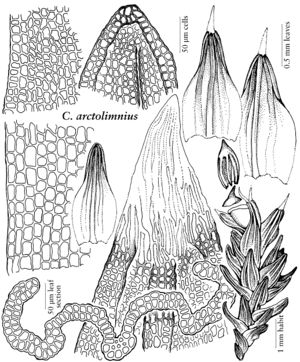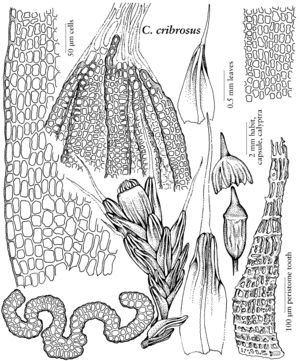Coscinodon
Anleit. Kenntn. Gew. 3: 281. 1804 ,.
| Taxon | Illustrator ⠉ | |
|---|---|---|
 | Coscinodon arctolimnius | Patricia M. Eckel |
 | Coscinodon cribrosus | Patricia M. Eckel |
 | Coscinodon yukonensis | Patricia M. Eckel |
Plants 4.5–15 mm, in dense cushions to loose mats, olivaceous to dark black-green. Leaves oval to ovatelanceolate, keeled distally, margins plane, incurved, or recurved, distal lamina 1-stratose or 2-stratose, specialized laminal and marginal chlorophyllose structures absent, usually long-awned; basal-cells usually rectangular with straight walls; mid leaf and distal cells quadrate to short rectangular, straight or sinuose, usually thick-walled. Gemmae absent. Sexual condition autoicous or dioicous; perichaetial leaves enlarged. Seta short to long, straight. Capsule erect, immersed to exserted, symmetric, campanulate, ovoid to cylindrical, rarely cupulate; annulus poorly differentiated; operculum conic to rostrate, falling detached from the columella. Calyptra campanulate, becoming cucullate with age, erose at base, large, covering 1/2 to all of capsule, plicate.
Distribution
North America, South America, Eurasia
Discussion
Species 10 (5 in the flora).
Species of Coscinodon are widespread across North America but are largely absent from the interior Great Plains and along the west coast. They all prefer dry acidic rocks. The largely calcareous regions of the continental interior do not provide suitable habitat for these species. Historically, North American authors have often considered Coscinodon to be a subgenus of Grimmia. Not until the 1980s did they follow the European approach distinguishing the two genera, the separation of which is based largely on the sporophyte. Coscinodon have large, campanulate, plicate calyptrae that commonly cover the capsule, whereas Grimmia have smaller, non-plicate calyptrae that are not campanulate. It is often stated that Coscinodon have very long awns compared to most Grimmia. This is true for the widespread species, C. calyptratus and C. cribrosus, and also C. yukonensis. But C. arctolimnius is muticous to short-awned and C. hartzii has awns not much longer than those of most Grimmia.
Selected References
Lower Taxa
Key
| 1 | Leaves non-plicate; lamina distally 1-stratose; leaf margins plane or recurved on one side at midleaf | > 2 |
| 1 | Leaves plicate at least in distal lamina; lamina distally 2-stratose; leaf margins incurved distally | > 3 |
| 2 | Autoicous; capsule exserted; peristome solid; leaves 1.4-2.4 mm, narrowly ovate-lanceolate, margins plane or recurved on one side at midleaf; western North America. | Coscinodon calyptratus |
| 2 | Dioicous; capsule immersed; peristome scalloped; leaves 0.9-1.2 mm, broadly ovate- lanceolate, margins plane; northern British Columbia to Alaska. | Coscinodon yukonensis |
| 3 | Capsule exserted; peristome present, xerocastique; leaf plications never to base; arctic. | Coscinodon hartzii |
| 3 | Capsule immersed; peristome present and hygrocastique or absent; leaf plications variable; temperate to arctic | > 4 |
| 4 | Peristome present; leaves never cucullate, plications not always reaching base; frequently long-awned; plants dark olivaceous; temperate to arctic. | Coscinodon cribrosus |
| 4 | Peristome absent; leaf apex often cucullate if muticous, inrolled if awned; plications extending to base; often muticous or with short awns; plants dark black-green; Arctic. | Coscinodon arctolimnius |